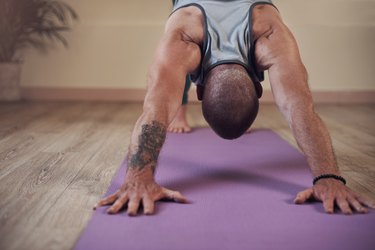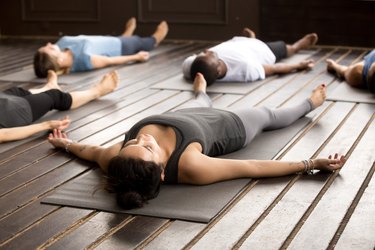
Not a fan of the way many interval workouts — like HIIT and circuit training — leave you breathless and racing against the clock? Try breath-based interval training.
This modality of interval training puts more focus on your body, allowing you to fine-tune your form and get both your body and mind into a more comfortable space.
Video of the Day
Read on to learn more about breath-based intervals, and try out our expert-crafted, breath-based workout.
What Are Breath-Based Intervals?
When doing rep- or time-based intervals, sometimes people work so hard or so quickly that form breaks down and they risk injury. Or, they can go in the opposite direction and go a little too easy on themselves, says Lore McSpadden-Walker, CPT, Original Strength trainer and founder of Positive Force Movement.
The difference with breath-based interval workouts is that the focus is on, well, your breath — inhaling and exhaling through your nose — until you're working hard enough that you have to breathe through your mouth. (FYI, you can move more air in and out through your mouth than your nose. So once your body hits a certain intensity, you'll have to start mouth breathing.) At that point, you stop the exercise and rest long enough that you can go back to breathing solely through your nose.
Breathing this way helps you listen to your body and gain a better understanding of how hard you're actually working, McSpadden-Walker says. It also helps you exercise at the intensity that fits your body — opposed to locking you into a certain rep or time constraint. (More benefits below!)
You can apply this interval technique to any activity, including kettlebell exercises and treadmill workouts. (Just skip it for heavy weight training. You want to follow precise breathing, rep, set and rest schemes there.)
3 Benefits of Breath-Based Intervals
1. They Make Your Workout More Enjoyable
Many people constantly stay in a sympathetic state, also called the fight-or-flight mode, during interval workouts. Rushing and stressing through your exercises doesn't make for a great experience.
"But if you breathe in a way that encourages your body to get and stay in the parasympathetic state — the rest-and-digest part of it — it's going to help movements feel safer and it's going to help you enjoy movement more," McSpadden-Walker says.
2. They Build Up Your Mental Toughness
By focusing on your breath, you're able to train through the most challenging parts of exercise — the parts that make you want to drop that weight and release that plank — and instead, keep going.
"Even if it's an intensely challenging movement, the body is reading it as, 'this is a safe place. This is an empowering place. This is a place I want to return to,'" says Prince Brathwaite, CPT, a certified trainer and owner of Trooper Fitness in New York City. "And it encourages people to develop an ongoing and sustainable movement practice that is more joyful and more playful."
3. They Tune You Into Your Body
Another benefit to this kind of interval is that it helps you connect your mind and body. By drawing this connection, you can work through mental blocks that are keeping you from moving forward — literally and metaphorically. It's especially helpful for those who have a history of trauma, PTSD or anxiety.
"I work with a lot of trauma survivors, so definitely finding a way that encourages a level of attention to what's going on in your body — without it being so overwhelming that it can be triggering — can be really helpful," McSpadden-Walker says.
Try This 20-Minute Breath-Based Interval Workout
Do each exercise below for as long as you can while breathing in and out through the nose. When you start needing to breathe through the mouth, rest. Then, start working again when you can get back to nose breathing. Repeat for the next exercise. Do as many rounds as feels good to you, adding up to 20 minutes.
The main thing with this breath-based interval workout is that you want to stay curious about what your body's telling you, McSpadden-Walker says. You may find that breathing comes relatively easy during one move, and not at all during the next exercise. This could simply mean that that exercise isn't the right one for you in this moment.
"If your body says no, you don't need to bully yourself," they say. "You have infinite freedom in how you approach these movements."
Move 1: Leopard Rotation
- Start on all fours with your knees under your hips and your wrists under your shoulders. Lift your knees just a few inches off the floor. If it's more accessible for you, keep your knees on the floor.
- Take one small step forward with your right arm and left foot.
- Then take one small step forward with your left arm and right foot.
- Continue alternating until you reach the end of a mat or the room.
- Then take it backward, stepping the opposite arm and foot behind you.
- Continue until you start mouth breathing.
Move 2: Frog Roll
- Start lying on your abdomen with your forearms on the floor and your elbows under your shoulders.
- Roll toward your right side, connecting your left elbow to your left thigh, and come up to a seated position.
- Roll back to the starting position.
- Repeat, rolling to the left side, connecting your right elbow and right thigh as you come up to a seated position.
- Continue alternating until you start mouth breathing.
Move 3: Turkish Get-Up
- Lie in the fetal position on the floor, facing your right side. Hold a kettlebell in your right hand, with your arm bent and the ball portion resting against the back of your wrist.
- Roll over toward your left to lie face up, putting both feet on the floor with your knees bent.
- Straighten both arms upward, pressing the kettlebell straight up over your shoulder.
- Lower your left arm and leg to your left side, both at a 45-degree angle from your body.
- Keep your eyes on the kettlebell and your right arm straight up over your shoulder throughout the entire exercise.
- Roll onto your left elbow, bringing your right shoulder off the floor. Keep the kettlebell straight over your shoulder.
- Keep your hips on the floor as you straighten your left arm and corkscrew your hand into the floor, pushing your torso farther upright.
- Reposition your right foot so that you can support your weight on your left hand and your right foot, using your core to keep your body steady.
- Press through your right foot to raise your hips off the floor. Bring your left leg underneath you and slightly behind your hips so that you can kneel on your left knee. The ball of your left foot should be in contact with the floor.
- Shift your torso to get into a lunge position with your left knee still on the floor. This will bring your left hand off the floor, while the kettlebell remains straight up over your right shoulder.
- Stand up, bringing your left leg forward so that you end up with your feet hip-width apart.
- Reverse the motion, step by step, to end lying face-up on the floor.
- Carefully bend your right arm and bring the kettlebell back to the floor to complete the repetition, using your left arm for an assist as needed.
- Repeat until you start mouth breathing.
Move 4: Leopard Rotation
- Start on all fours with your knees under your hips and your wrists under your shoulders. Lift your knees just a few inches off the floor.
- Drop your hips toward the right, keeping your knees just a few inches off the floor.
- Then bring them back through the center to the left side.
- Continue alternating until you start mouth breathing.
Move 5: Cross Crawl
- Stand with your feet hip-width apart and your arms by your sides.
- Drive your right knee up, connecting your left hand, forearm or elbow to your right thigh.
- Step your right foot back down and bring your arms back to your sides.
- Then, drive your left knee up, connecting your right hand, forearm or elbow to your left thigh.
- Step your left foot back down and drop your arms back to your sides.
- Continue alternating until you start mouth breathing.



